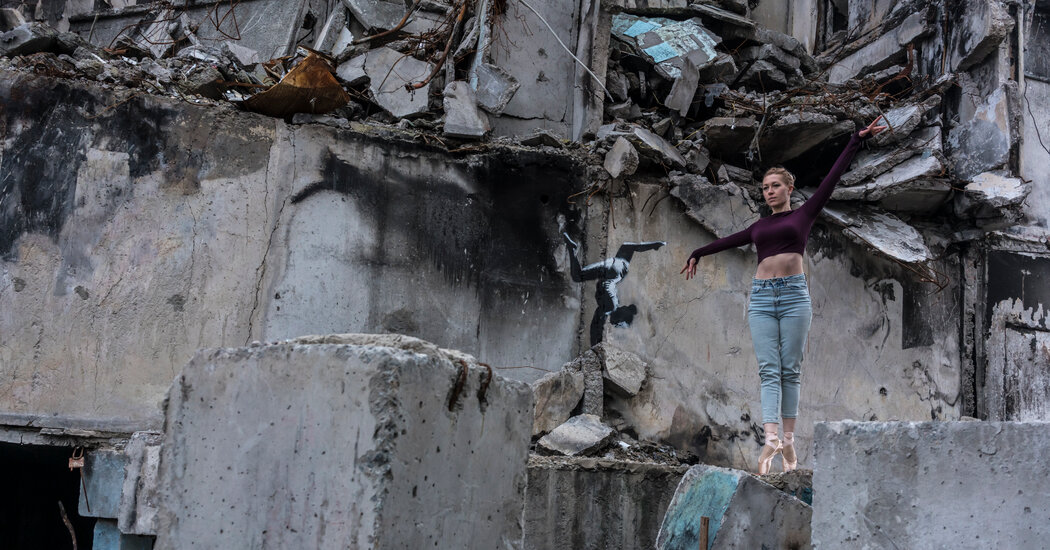KYIV, Ukraine — Many Ukrainians saw messages of defiance and resilience in the seven artworks painted last month by Banksy, the British street artist, on war-ravaged buildings in and around Kyiv.
At least one activist saw another kind of benefit: He removed one of the works, saying he intended to auction it and donate the proceeds to the Ukrainian Army.
The activist, Serhiy Dovhyi, says he is now under criminal investigation for removing the work from a wall in the Kyiv suburb of Hostomel. The depiction, of a woman in a bathrobe wearing a gas mask and holding a fire extinguisher, suggests the war’s intrusion on home life. A Ukrainian art dealer has estimated that the work is worth up to $1 million.
Under wartime authorities, the Ukrainian military appoints local leaders. The military-appointed head of Hostomel told local media that the art should go into a future memorial to war or remain on the site, to become part of a future building.
It isn’t the first time ownership of one of Banksy’s works has been in dispute. In 2014, a Banksy painting appeared on a piece of plywood secured to the Broad Plain Boys Club in Bristol, England. The club’s owner, Dennis Stinchcombe, planned to auction the painting to raise money for the club, but the city stepped in and claimed it owned the depiction of a couple embracing and staring at their cellphones. In a rare public move, Banksy wrote a letter saying the art should be used to help the club.
In the Ukraine dispute, Mr. Dovhyi said in an interview that the artwork had to be saved because the wall on which it was painted was scheduled to be demolished soon. He described the act of removing the graffiti, which he documented in videos, as an additional act of performance art that might add to its value.
Mr. Dovhyi cut the graffiti from the wall in Hostomel on Dec. 2 by removing a layer of insulation on the ruined building’s exterior. .
“Street art, in contrast to a piece of art in the Louvre, doesn’t belong to anyone,” he said.
The action did, in any case, succeed in stirring discussion in Ukraine about the future of Banksy’s local works. The art appeared in the suburban towns Hostomel, Irpin and Borodyanka, where hundreds of civilians died early in the war in air and artillery strikes and summary executions.
For nearly two decades, Banksy has maintained his anonymity, while creating art, often with social and political undertones, in New York City, London, the West Bank and many other places.
Banksy’s work has also included stunts. In 2018, his painting “Girl With Balloon” self-destructed in a remote-controlled shredder moments after Sotheby’s in London auctioned it for $1.4 million. The apparent commentary on the excesses of the art market only enhanced the work’s value: Retitled “Love Is in the Bin,” Sotheby’s resold it last year for $25.4 million.
But Banksy also goes to great lengths to regulate the resale of his graffiti and prevent fakes, working with a team that authenticates his work. Reputable dealers and auction houses sell Banksy works only with certification.
Banksy has already sold art to benefit Ukraine. In March, he donated proceeds from the sale of a painting to the Okhmatdyt children’s hospital in Kyiv.
Mr. Dovhyi argued that the army’s needs during wartime justified the attempt to sell the painting of the woman in the bathrobe. “I wanted to capitalize as much as possible,” he said, “and all the money would go to humanitarian and military purposes.”
But the police turned up soon after he had cut the art from the wall, confiscating the slab of insulation and questioning Mr. Dovhyi and others in his group. Mr. Dovhyi said police told him the investigation is under an article of the criminal code that deals with property damage less severe than vandalism. He has not been charged.
Evelina Riabenko contributed reporting.



